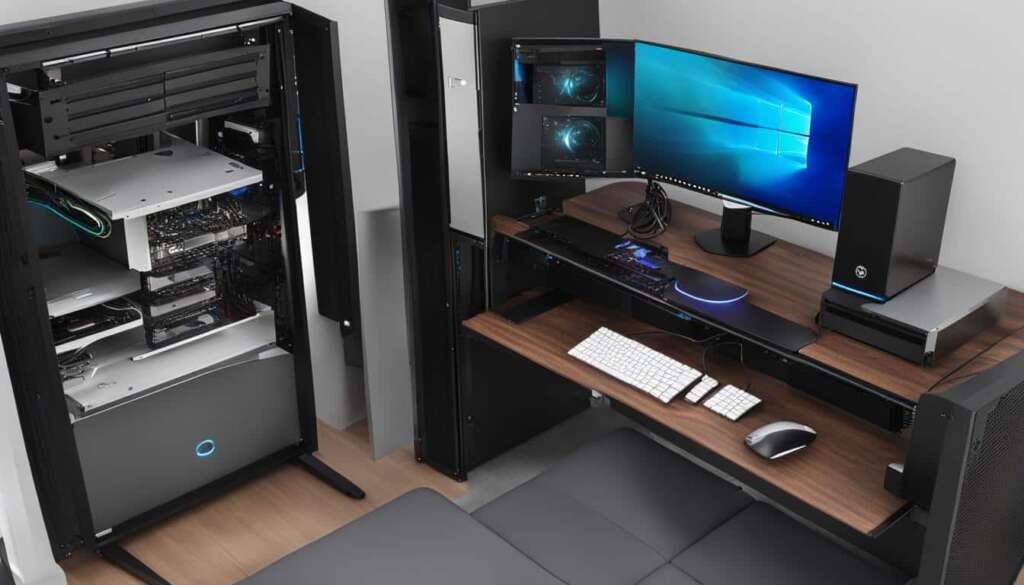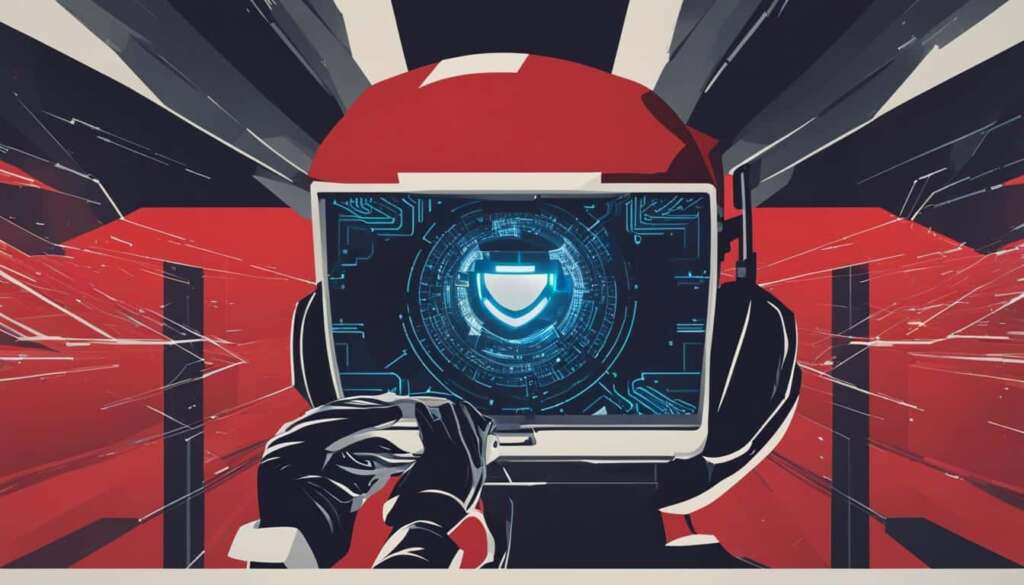Table of Contents
Welcome to our comprehensive guide on efficient cable management for PC enthusiasts. In this article, we will provide you with strategies and techniques to achieve tidy and organized cable management for your computer system. Proper cable management is crucial not only for the aesthetics of your PC but also for its overall performance and functionality.
When it comes to cable management, it’s important to consider aspects such as cable organization, wire management, cable tidy solutions, cable storage, cord management, cable routing, cable clips, and more. By implementing these practices, you can improve airflow, reduce dust accumulation, and simplify future upgrades.
Whether you are a system builder or an upgrader, this guide will equip you with the knowledge and tools to efficiently manage your cables. So, let’s dive in and discover the benefits of proper cable management and how you can achieve it.
The Importance of Component Placement and Selection
When it comes to efficient cable management, the placement and selection of components is crucial. By carefully considering these factors, you can greatly reduce cable clutter and improve the overall aesthetics and functionality of your PC. One important consideration is investing in a case that features rubberized routing holes and tie-down spots. These features make it easier to route and secure cables, resulting in a cleaner and more organized setup.
A modular power supply unit is another essential component for effective cable management. With a modular PSU, you only need to connect the cables that are necessary for your specific configuration. This eliminates the need for excess cables, reducing cable clutter and improving airflow within the case. Additionally, modular PSUs often come with shorter cables, making it easier to route them neatly and keep them out of the way of other components.
Choosing a case with rubberized routing holes and investing in a modular power supply unit are simple yet effective ways to significantly reduce cable clutter and improve airflow within your PC.
By carefully considering component placement and selection, you can create a clean and tidy cable management system that not only enhances the overall look of your PC but also improves its functionality and performance. Take advantage of cases with features like rubberized routing holes, tie-down spots, and modular power supply units to achieve optimal cable management and enjoy a clutter-free computing experience.
Strategies for Smart Cable Routing
Proper cable routing is crucial for achieving efficient cable management. By strategically routing your cables, you can improve airflow, enhance the aesthetic appearance of your PC, and prevent cable interference with components. Here are some strategies to help you achieve smart cable routing:
1. Snake Cables Behind the Motherboard Tray
One effective technique is to snake your cables behind the motherboard tray. This not only keeps them hidden from view but also prevents them from obstructing airflow. By neatly routing your cables, you can ensure that cool air can flow freely through your PC, reducing the risk of overheating and improving overall performance.
2. Prioritize Cable Placement
When routing your cables, it’s important to prioritize their placement. Begin by connecting front-panel and case-related cables, such as USB and audio connectors. Next, focus on data cables for drives, such as SATA and power cables for your storage devices. Finally, route and connect the power supply cables, ensuring they are secured tightly to avoid any cable clutter.
3. Bundle Excess Cables
One common challenge in cable management is dealing with excess cables. To keep your system clutter-free, bundle up any excess cables and secure them tightly. This not only improves the overall appearance of your build but also helps maintain airflow by preventing loose cables from getting in the way of components or fans.
| Benefits of Smart Cable Routing |
|---|
| Improved airflow |
| Enhanced aesthetic appearance |
| Prevention of cable interference |
| Reduced risk of overheating |
By employing these smart cable routing strategies, you can achieve tidy cable management and optimize the performance of your PC. Remember to plan ahead, prioritize cable placement, and bundle excess cables to ensure a clean and organized system. Implementing these techniques will not only result in a visually appealing build but also contribute to better airflow and overall system efficiency.
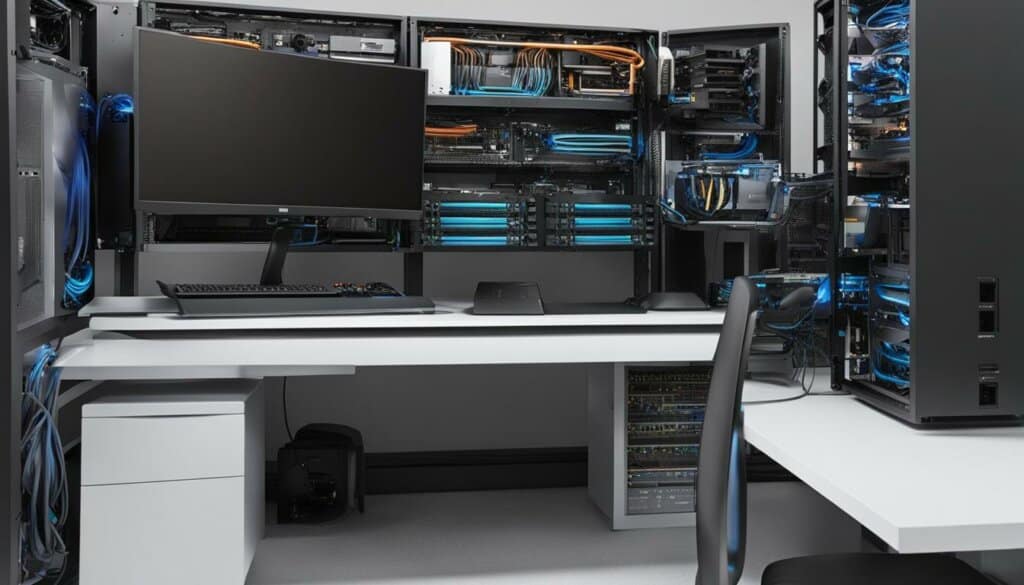
Recommended Tools for Cable Management
When it comes to achieving efficient cable management, having the right tools at your disposal is crucial. These tools can help you secure, organize, and streamline your cables, resulting in a neater and more visually appealing setup. Here are some recommended tools for effective cable management:
Cable Ties
Cable ties are a versatile and affordable solution for bundling and securing cables. They come in various sizes and materials, allowing you to choose the right ones for your specific needs. Use cable ties to group cables together and keep them organized, minimizing the chance of tangling or cluttering.
Zip Ties
Similar to cable ties, zip ties are another popular option for cable management. They are easy to use and provide a strong hold, keeping your cables neatly in place. However, it’s important to note that zip ties may need to be cut for removal, which can be a disadvantage if you frequently add or remove cables. Consider reusable options for added flexibility.
Cable Combs
Cable combs are specially designed to align and separate individual cables, creating a clean and organized appearance. They are commonly used for managing cables that run from your power supply to your motherboard or graphics card. By using cable combs, you can prevent cables from tangling or overlapping, resulting in a more professional-looking build.
Cable Sleeves
Cable sleeves are an excellent choice if you want to hide and streamline your cables. These sleeves encase individual cables, providing a clean and uniform look. Cable sleeves come in a variety of colors and materials, allowing you to match them to your system’s color scheme. Additionally, cable sleeves can also help protect your cables from damage and prolong their lifespan.
Adhesive Tie Downs
Adhesive tie downs are small, sticky pads that allow you to secure cables to various surfaces, such as the backside of your case or the inside of cable channels. These tie downs are easy to use and provide a secure hold, ensuring that your cables stay in place. They are particularly useful for managing cables that need to be routed along specific paths.
| Tool | Function |
|---|---|
| Cable Ties | Bundling and securing cables |
| Zip Ties | Securing cables with a strong hold |
| Cable Combs | Aligning and separating cables for a clean look |
| Cable Sleeves | Hiding and streamlining cables |
| Adhesive Tie Downs | Securing cables to surfaces |
By utilizing these recommended tools, you can efficiently manage your cables and create a more organized and visually pleasing PC setup.
Benefits of Tidy Cable Management
Tidy cable management offers several benefits that can greatly enhance the performance and aesthetics of your PC. By organizing and securing your cables properly, you can achieve improved airflow, cooling efficiency, easier troubleshooting, and a more visually appealing setup.
Achieve Improved Airflow
Efficient cable management plays a crucial role in maintaining optimal airflow within your PC. When cables are neatly routed and secured, they are less likely to obstruct the path of cool air flowing through the case. This allows for better circulation and helps prevent heat buildup, which can lead to thermal throttling and decreased performance. Improved airflow also contributes to a cooler and quieter operation, ensuring that your PC operates at its best.
Enhance Cooling Efficiency
Proper cable management can significantly improve the cooling efficiency of your PC. When cables are organized and kept away from components like CPU and GPU coolers, they won’t obstruct the airflow generated by the cooling fans. This allows the cool air to reach crucial components more effectively, ensuring that they stay within their optimal temperature ranges. With better cooling efficiency, your PC can maintain stable performance even during demanding tasks and prolonged usage.
Easier Troubleshooting
Tidy cable management can also make troubleshooting easier and more efficient. When cables are neatly arranged and labeled, it becomes much easier to identify and trace specific cables when needed. This can be particularly helpful when diagnosing hardware issues or making changes to your system’s configuration. With clear and organized cables, you can quickly locate and address any potential problems, saving you time and effort in the process.
Aesthetic Appeal
Aside from the practical benefits, tidy cable management also enhances the aesthetic appeal of your PC. A clean and organized interior not only showcases your attention to detail but also creates a visually pleasing and professional-looking setup. By hiding cables, utilizing cable management solutions, and routing cables strategically, you can achieve a clutter-free and streamlined appearance that adds to the overall visual appeal of your PC.
| Benefits of Tidy Cable Management |
|---|
| Improved airflow |
| Cooling efficiency |
| Easier troubleshooting |
| Aesthetic appeal |
Planning Ahead for Effective Cable Management
Before assembling your PC, it’s crucial to plan your cable management strategy to ensure a clean and organized system. By considering optimal routing paths, hiding and securing cables, you can achieve efficient cable management that not only improves aesthetics but also promotes better airflow and ease of maintenance.
When planning your cable management strategy, start by identifying the optimal routing paths for each cable type. This involves determining the most direct and efficient routes that minimize cable clutter and prevent cables from obstructing airflow or interfering with components. Take into account the length of each cable and position components accordingly to reduce excess cable length.
Next, explore opportunities for hiding and securing cables. Many modern PC cases offer cable management features such as hidden compartments, cable channels, and tie-down spots. These can be utilized to keep cables organized and hidden from view, creating a cleaner and more professional-looking interior. Additionally, consider using cable sleeves or adhesive tie downs to bundle and secure cables together, further reducing clutter and improving airflow.
Benefits of Planning Ahead
“By planning ahead for effective cable management, you can save time and effort during the assembly process and ensure a tidy and efficient system. It allows for easier troubleshooting and component upgrades, as cables are neatly organized and accessible. Furthermore, planning ahead minimizes the risk of cable tangling and damage, prolonging the lifespan of your cables and components.”
By taking the time to plan your cable management strategy before assembling your PC, you can optimize cable routing, hide and secure cables effectively, and achieve a clean and organized system. This careful planning will not only improve the overall aesthetics of your build but also contribute to better airflow, easier maintenance, and enhanced longevity of your components.
Organizing Power and Data Cables
Properly organizing power and data cables is a crucial part of efficient cable management. It not only improves the overall aesthetics of your PC but also ensures better airflow and easy maintenance. In this section, we will discuss effective strategies for power cable routing, cable bundling, data cable grouping, and utilizing cable channels to keep your cables organized and hidden.
When it comes to power cable routing, it is important to route them along the backside of the case to keep them out of sight. Use cable ties or Velcro straps to bundle them together neatly, making sure they are not obstructing the airflow within the case. By keeping the power cables organized and hidden, you can maintain a clean and clutter-free interior.
“Proper cable management is not only about organizing cables but also about ensuring the efficient flow of air within the case.”
Data cables such as SATA, USB, and audio cables should be grouped separately from the power cables. Use cable combs or Velcro ties to bundle them together, making it easier to identify and manage specific cables. By grouping the data cables, you can reduce cable clutter and create a more organized and visually appealing system.
Utilizing cable channels or hidden compartments in your case is another effective way to keep your cables organized and hidden. These channels can provide dedicated pathways for routing cables, allowing you to keep them out of sight and preventing them from interfering with other components. Take advantage of these features to achieve a clean and professional-looking cable management system.
By following these strategies for power cable routing, cable bundling, data cable grouping, and utilizing cable channels, you can ensure that your cables are organized, hidden, and properly managed. Not only will this enhance the overall aesthetics of your PC, but it will also provide better airflow and make maintenance tasks much easier.
| Benefits of Organized Power and Data Cables: |
|---|
| + Improved airflow |
| + Easier maintenance |
| + Clutter-free interior |
| + Professional-looking system |
Cable Management for Cooling Solutions
Proper cable management is essential for maintaining optimal cooling solutions in your PC. Failure to manage cables effectively can result in cooler cables obstructing airflow, leading to decreased cooling efficiency and potential overheating issues. In this section, we will explore the importance of cable management for CPU and GPU cooling and provide practical tips to ensure your cables do not hinder the performance of your cooling solutions.
The Impact of Cooler Cables
When cables block the airflow around CPU and GPU coolers, it can disrupt the intended cooling process. Cooler cables obstructing airflow can cause hot air to accumulate around these components, resulting in increased temperatures and potentially decreasing the lifespan of your hardware. To prevent this, it is crucial to organize and secure cables in a way that allows for unobstructed airflow.
Tips for Effective Cable Management
Here are some tips to help you achieve efficient cable management for cooling solutions:
- Route cables away from CPU and GPU coolers: Ensure that cables are directed away from the path of airflow generated by your cooling solutions. This will prevent any interference that might hinder the coolers’ performance.
- Secure cables neatly: Use cable ties, adhesive tie downs, or cable clips to secure cables and keep them in place. By securing cables tightly, you can minimize the chance of them coming loose and obstructing airflow.
- Utilize cable management features: Take advantage of cable routing holes and tie-down spots in your case to guide cables away from cooling solutions. This will help keep cables organized and prevent them from interfering with airflow.
Importance of Regular Maintenance
Remember to regularly inspect your cable management setup to ensure cables have not shifted or become loose. As you make changes or upgrades to your system, take the opportunity to reevaluate and optimize cable routing. By staying vigilant and maintaining proper cable management, you can ensure efficient cooling solutions and extend the lifespan of your PC components.
| Tips for Effective Cable Management for Cooling Solutions |
|---|
| 1. Route cables away from CPU and GPU coolers |
| 2. Secure cables neatly using cable ties, adhesive tie downs, or cable clips |
| 3. Utilize cable management features in your case |
Proper cable management for cooling solutions is crucial for maintaining optimal performance and preventing overheating. By following these tips, you can ensure that your cooler cables do not obstruct airflow, allowing your CPU and GPU coolers to effectively dissipate heat and keep your system running smoothly.
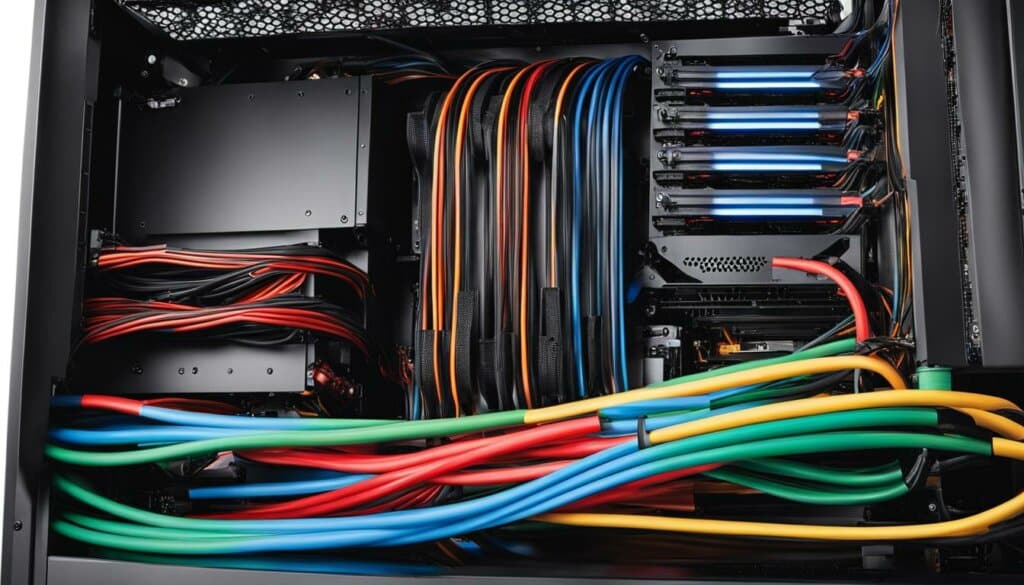
Cable Management for Peripherals
When it comes to cable management, it’s not just the cables inside your PC that need attention. Peripherals like monitors, keyboards, and mice can contribute to cable clutter on your desk. To maintain a clean and organized workspace, here are some tips for managing cables for peripherals.
If possible, consider using wireless peripherals. Wireless keyboards, mice, and even wireless charging pads for your phone can help eliminate the need for cables altogether. Not only does this reduce cable clutter, but it also gives you more freedom to arrange your desk without being restricted by cable lengths.
If you prefer wired peripherals or have devices that don’t have wireless options, investing in custom cables can make a noticeable difference in cable management. Custom cables are designed to be shorter and more tailored to your specific setup, reducing excess cable length and minimizing tangles. They also come in a variety of colors, allowing you to match the aesthetic of your workspace.
Lastly, consider using cable hiding options to keep your desk free from visible cables. Cable clips or cable management boxes can help route and hide cables, keeping them out of sight and organized. Another option is to use cable sleeves, which bundle multiple cables together and provide a streamlined look. These sleeves can be easily installed and removed when needed.
| Advantages of Cable Management for Peripherals | Disadvantages of Cable Clutter |
|---|---|
|
|
Proper cable management for peripherals not only enhances the visual appeal of your workspace but also improves functionality. It reduces cable tangling and makes it easier to clean and maintain your desk. Investing in wireless peripherals or custom cables can further streamline your setup and eliminate cable clutter. Don’t forget to utilize cable hiding options like clips, management boxes, or sleeves to keep your desk organized and free from visible cables.
Keeping Cables Hidden and Organized on the Desk
When it comes to cable management, it’s not just about organizing the cables inside your PC. Keeping the cables on your desk neat and tidy is equally important for creating an organized workspace. Not only does it improve the aesthetics of your desk, but it also helps to maintain a clutter-free environment, making it easier to focus on your work.
One of the simplest and most effective ways to keep your cables organized on the desk is by using cable ties. Cable ties are inexpensive and easy to use. They allow you to bundle cables together neatly, preventing them from tangling and creating a mess. You can find cable ties in various colors and sizes to match your desk decor or personal preference.
Another option to consider is using cable sleeves. Cable sleeves are flexible tubes that you can slide over your cables to give them a clean and streamlined appearance. They come in different lengths and diameters to accommodate different cable sizes. Cable sleeves not only help manage your cables but also protect them from damage and wear over time.
If you want a more advanced solution for cable management on your desk, you can explore the use of cable management racks. These racks provide a dedicated space to route and store your cables, keeping them organized and hidden from view. Cable management racks come in various sizes and designs, allowing you to choose the one that best fits your desk setup.
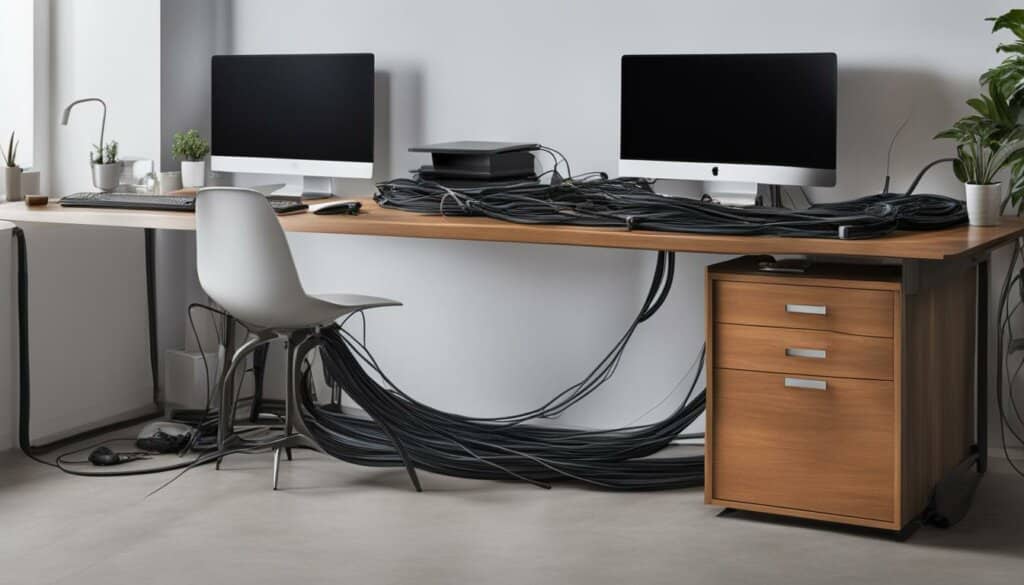
Benefits of Keeping Cables Hidden and Organized on the Desk
Keeping your cables hidden and organized on the desk offers several benefits. Firstly, it creates a cleaner and more professional-looking workspace. You’ll no longer have to deal with cable clutter and the visual distraction it can cause. Secondly, it simplifies cable maintenance and troubleshooting. With organized cables, you can easily identify and access specific cables when needed. Lastly, it promotes a safer work environment by minimizing trip hazards and reducing the risk of accidental cable damage.
By implementing these cable management techniques on your desk, you can create a more efficient and productive workspace. Whether you choose to use cable ties, cable sleeves, or cable management racks, taking the time to organize your cables will pay off in the long run.
Tips for Proper Cable Management
Proper cable management is crucial for a clean and organized PC setup. Follow these tips to ensure efficient cable routing, reduce clutter, and create a visually appealing workspace.
Snip Excess Cable Ties
When securing cables with cable ties, it’s common to have excess length sticking out. To maintain a neat and tidy appearance, use a wire cutter to snip off the excess. This will prevent cables from tangling or looking untidy.
Utilize Decorative Features
Enhance the aesthetics of your cable management by using decorative features to hide cables. Incorporate desk plants, bookends, or cable management boxes to camouflage cables and create a more visually appealing workspace.
Invest in Cable Management Tools
To make cable management easier, invest in tools designed specifically for the task. Cable management solutions like cable clips, cable sleeves, and cable combs can help keep cables organized and prevent them from tangling. Consider using adhesive tie downs or cable channels to secure and route cables neatly behind your desk or PC.
Consider Wireless Peripherals or Custom Cables
To further reduce cable clutter, consider using wireless peripherals such as keyboards and mice. This eliminates the need for cables altogether. Alternatively, you can invest in custom cables that are shorter in length and specifically tailored to your setup, further reducing cable clutter.
Plan Ahead for Future Upgrades
When managing cables, it’s important to plan for future upgrades or changes to your setup. Leave ample slack in your cables and ensure they can be easily disconnected and reconnected when needed. This will make future upgrades or modifications much easier.
Summary
Efficient cable management is essential for a clean, organized, and functional PC setup. By snipping excess cable ties, utilizing decorative features, investing in cable management tools, considering wireless peripherals or custom cables, and planning for future upgrades, you can achieve an aesthetically pleasing and clutter-free workspace.
Conclusion
Efficient cable management is an essential aspect of PC building. It offers numerous benefits such as improved airflow, cooling efficiency, easier troubleshooting, and aesthetic appeal. By following the strategies and tips outlined in this guide, you can achieve tidy cable organization and efficient cable routing for a better overall PC experience.
Tidy cable management not only enhances the aesthetics of your PC, but also has practical advantages. Properly routed and secured cables promote better airflow, resulting in cooler and quieter operation. Additionally, a well-organized cable system prevents dust accumulation and makes future upgrades easier.
Remember to plan ahead, considering optimal cable routing paths and areas to hide and secure cables. Utilize tools like cable ties, cable combs, and cable sleeves to keep cables neatly bundled and aligned. And don’t forget to organize power and data cables, as well as cables for cooling solutions and peripherals.
By implementing these cable management techniques and employing the right tools, you can achieve an organized and efficient cable system that not only improves the functionality of your PC, but also enhances its overall appearance. So, take the time to invest in cable management and enjoy the benefits it brings to your PC setup.
FAQ
Why is cable management important?
Cable management is important for several reasons. It improves airflow, reduces dust accumulation, enhances cooling efficiency, simplifies troubleshooting, and enhances the aesthetic appeal of your PC.
How does component placement and selection impact cable management?
Cases designed for enthusiasts often have features like rubberized routing holes and tie-down spots, making it easier to manage cables. Investing in a case with these features and a modular power supply unit can greatly reduce cable clutter and improve airflow.
What are some tips for smart cable routing?
Start by connecting front-panel and case-related cables, followed by data cables for drives, and finally the power supply. Snaking cables behind the motherboard tray and routing them neatly will improve airflow and prevent cable interference with components.
What tools are recommended for cable management?
Cable ties, zip ties, adhesive tie downs, cable combs, and cable sleeves are ideal for securing and bundling cables. Reusable options are preferred over zip ties that need to be cut for removal.
What are the benefits of tidy cable management?
Tidy cable management improves airflow, cooling efficiency, and makes troubleshooting and component upgrades easier. It also enhances the aesthetic appeal of your PC.
How do I plan for effective cable management?
Consider the optimal routing paths for each cable type and identify areas where cables can be hidden or secured. Pre-planning will help achieve effective cable management and reduce clutter.
How do I organize power and data cables?
Route power supply cables along the backside of the case, using cable ties or Velcro straps to bundle them together neatly. Separate data cables like SATA, USB, and audio cables, and bundle them using cable combs or Velcro ties. Use cable channels or hidden compartments in your case to keep cables organized and hidden.
How should I manage cables for cooling solutions?
Make sure cables for CPU and GPU coolers are arranged to avoid obstructing airflow and interfering with fans. Secure these cables neatly to prevent any disruption to cooling efficiency.
What about cable management for peripherals?
Reduce cable clutter by using wireless peripherals or investing in custom cables. Hide cables behind decor or use cable management tools like cable ties, cable sleeves, or cable management boxes.
Use cable ties or cable sleeves to bundle and hide cables. Route them under the desk or use cable management racks to keep them hidden and secure. Choose desk accessories that can help hide cables and keep your workspace neat.
What are some tips for proper cable management?
Snip off excess cable tie length with a wire cutter, use decor to hide cables, invest in modular power supplies and cases with cable management features, and use wireless peripherals or custom cables to reduce cable clutter.

